The sunbirds and spiderhunters make up a family, Nectariniidae, of very small passerine birds. There are 132 species in 15 genera. The family is distributed throughout Africa, the Indian Subcontinent, Southeast Asia and just reaches northern Australia. Most sunbirds feed largely on nectar, but also take insects and spiders, especially when feeding young. Flower tubes that bar access to nectar because of their shape, are simply punctured at the base near the nectaries. Fruit is also part of the diet of some species. Their flight is fast and direct on their short wings.
Sunbirds are strongly sexually dimorphic, with the males usually brilliantly plumaged in iridescent colours. In addition to this the tails of many species are longer in the males, and overall the males are larger. Sunbirds have long thin down-curved bills and brush-tipped tubular tongues, both adaptations to their nectar feeding.
Sunbirds are a tropical Old World family, with representatives in Africa, Asia and Australasia. In Africa they are found mostly in sub-Saharan Africa and Madagascar but are also distributed in Egypt. The greatest variety of species is found in Africa, where the group probably arose. Most species are sedentary or short-distance seasonal migrants. Sunbirds occur over the entire family's range, whereas the spiderhunters are restricted to Asia.
The sunbirds and spiderhunters occupy a wide range of habitats, with a majority of species being found in primary rainforest, but other habitats used by the family including disturbed secondary forest, open woodland, open scrub and savannah, coastal scrub and alpine forest. Some species have readily adapted to human modified landscapes such as plantations, gardens and agricultural land. Many species are able to occupy a wide range of habitats from sea level to 4900 m.
Sunbird are active diurnal birds that generally occur in pairs or occasionally in small family groups. A few species occasionally gather in larger groups, and sunbird will join with other birds to mob potential predators, although sunbirds will also aggressively target other species, even if they are not predators, when defending their territories.
The sunbirds that breed outside of the equatorial regions are mostly seasonal breeders, with the majority of these species breeding in the wet season. This timing reflects the increased availability of insect prey for the growing young. Where species, like the Buff-throated Sunbird, breed in the dry season, it is thought to be associated with the flowering of favoured food plants. Species of sunbird in the equatorial areas breed throughout the year. They are generally monogamous and often territorial, although a few species of sunbirds have lekking behaviour.
The nests of sunbirds are generally purse-shaped, enclosed, suspended from thin branches with generous use of spiderweb. The nests of the spiderhunters are different, both from the sunbirds and in some cases from each other. Some, like the Little Spiderhunter, are small woven cups attached to the underside of large leaves; that of the Yellow-eared Spiderhunter is similarly attached but is a long tube. The nests of spiderhunters are inconspicuous, in contrast to those of the other sunbirds which are more visible. In most species the female alone constructs the nest. Up to four eggs are laid. The female builds the nest and incubates the eggs alone, although the male assists in rearing the nestlings. The nests of sunbirds and spiderhunters are often targeted by brood parasites such as cuckoos and honeyguides.
Africa Wild Bird Book
Family Nectariniidae Index
Family Nectariniidae (Sunbirds)
Anthreptes reichenowi Plain-backed Sunbird 794
Anthreptes anchietae Anchieta's Sunbird
Anthreptes longuemarei Western Violet-backed Sunbird 795
Hedydipna collaris Collared Sunbird 793
Anthobaphes violacea Orange-breasted Sunbird 777
Cyanomitra olivacea Olive Sunbird 790
Cyanomitra veroxii Grey Sunbird 789
Chalcomitra amethystina Amethyst Sunbird 792
Chalcomitra senegalensis Scarlet-chested Sunbird 791
Nectarinia kilimensis Bronzy Sunbird 776
Nectarinia famosa Malachite Sunbird 775
Cinnyris manoensis Eastern Miombo Sunbird 784
Cinnyris chalybeus Southern Double-collared Sunbird 783
Cinnyris neergaardi Neergaard's Sunbird 782
Cinnyris afer Greater Double-collared Sunbird 785
Cinnyris mariquensis Marico Sunbird 779
Cinnyris shelleyi Shelley's Sunbird 781
Cinnyris bifasciatus Purple-banded Sunbird 780
Cinnyris talatala White-bellied Sunbird 787
Cinnyris venustus Variable Sunbird 786
Cinnyris fuscus Dusky Sunbird 788
Cinnyris cupreus Copper Sunbird 778
Anthreptes reichenowi Plain-backed Sunbird 794
Anthreptes anchietae Anchieta's Sunbird
Anthreptes longuemarei Western Violet-backed Sunbird 795
Hedydipna collaris Collared Sunbird 793
Anthobaphes violacea Orange-breasted Sunbird 777
Cyanomitra olivacea Olive Sunbird 790
Cyanomitra veroxii Grey Sunbird 789
Chalcomitra amethystina Amethyst Sunbird 792
Chalcomitra senegalensis Scarlet-chested Sunbird 791
Nectarinia kilimensis Bronzy Sunbird 776
Nectarinia famosa Malachite Sunbird 775
Cinnyris manoensis Eastern Miombo Sunbird 784
Cinnyris chalybeus Southern Double-collared Sunbird 783
Cinnyris neergaardi Neergaard's Sunbird 782
Cinnyris afer Greater Double-collared Sunbird 785
Cinnyris mariquensis Marico Sunbird 779
Cinnyris shelleyi Shelley's Sunbird 781
Cinnyris bifasciatus Purple-banded Sunbird 780
Cinnyris talatala White-bellied Sunbird 787
Cinnyris venustus Variable Sunbird 786
Cinnyris fuscus Dusky Sunbird 788
Cinnyris cupreus Copper Sunbird 778
Collared Sunbird
793. Collared Sunbird Hedydipna collaris (formerly: Anthreptes collaris) (Kortbeksuikerbekkie)
Order: Passeriformes. Family: Nectariniidae
Description
The Collared Sunbird has a height of 11 cm and weighs around 9 g. The smallest sunbird of the region, with a very short bill, only slightly decurved.
Adult male: No eclipse plumage. Upper parts, incl head, bright metallic green. Tail blackish, upper side with slight green gloss. Lesser and median coverts bright metallic green; remainder of coverts blackish brown, edged green. Flight feathers blackish brown, primaries narrowly edged olive green, secondaries and tertials edged metallic green. Chin and throat bright metallic green, bordered below by bluish-purple band across upper breast. Mid-breast to belly bright yellow or orange-yellow. Bill black; short, stout, and only slightly decurved. Eyes dark brown, eyelid wattle dark grey, almost black. Legs and feet black.
Adult female has similar irisdecent green upperparts without the chest-band, but entire underparts are yellow.
Juvenile is like dull pale female.
Distribution
Occurs in patches across sub-Saharan Africa, from Guinea to Ethiopia south to southern Africa. Here it is locally common in Mozambique, northern and south-eastern Zimbabwe, northern Botswana, Caprivi Strip (Namibia) and north-eastern and south-eastern South Africa.
H. c. zambesiana: se Angola to se Tanzania, n Zimbabwe and c Mozambique
H. c. zuluensis: e Zimbabwe, s Mozambique, Swaziland and ne South Africa
H. c. collaris: se South Africa
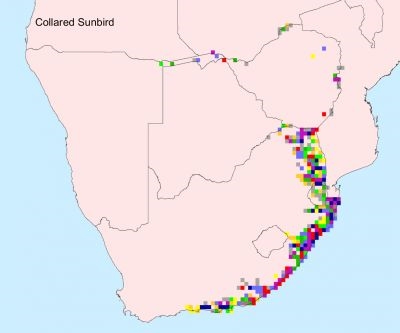
Habitat
It generally prefers Afromontane, coastal and lowland evergreen forest, or occasionally in thorny savanna and gardens adjacent to forests.
Diet
It mainly eats arthropods and nectar, gleaning prey from foliage and hawking insects aerially. It often joins mixed-species foraging flocks, along with other sunbirds, white-eyes and Green-backed camaropteras. This tiny sunbird, with its shorter bill, cannot reach into flowers, so vandalises them by piercing the corolla to extract the nectar. It also feeds on insects, clambering around.
Breeding
The nest is built solely by the female, consisting of an untidy oval-shaped structure built of dry grass, rootlets, twigs, tendrils and leaves bound together with spider web, with a tail material protruding from the base. The side entance is positioned on the side, with a small grass "porch" beneath it, while the interior is lined with wiry plant fibres, horse hair, rootlets and feathers. It is typically strung from the outer foliage of a sapling, shrub or creeper, often facing east with a wasp nest nearby. Egg-laying season is almost year-round, peaking from September to January. The female lays 1-4 eggs, which are incubated solely by the female for about 12-14 days, occasionally leaving the nest to go and forage. The chicks are mainly fed by the female, leaving the nest after about 13-17 days and becoming independent roughly 24 days later.
Call
Song high-pitched chirri, chirri, chirri or a soft tswee, contact call thin tsip. Listen to Bird Call.
Status
Common resident.
Order: Passeriformes. Family: Nectariniidae
Description
The Collared Sunbird has a height of 11 cm and weighs around 9 g. The smallest sunbird of the region, with a very short bill, only slightly decurved.
Adult male: No eclipse plumage. Upper parts, incl head, bright metallic green. Tail blackish, upper side with slight green gloss. Lesser and median coverts bright metallic green; remainder of coverts blackish brown, edged green. Flight feathers blackish brown, primaries narrowly edged olive green, secondaries and tertials edged metallic green. Chin and throat bright metallic green, bordered below by bluish-purple band across upper breast. Mid-breast to belly bright yellow or orange-yellow. Bill black; short, stout, and only slightly decurved. Eyes dark brown, eyelid wattle dark grey, almost black. Legs and feet black.
Adult female has similar irisdecent green upperparts without the chest-band, but entire underparts are yellow.
Juvenile is like dull pale female.
Distribution
Occurs in patches across sub-Saharan Africa, from Guinea to Ethiopia south to southern Africa. Here it is locally common in Mozambique, northern and south-eastern Zimbabwe, northern Botswana, Caprivi Strip (Namibia) and north-eastern and south-eastern South Africa.
H. c. zambesiana: se Angola to se Tanzania, n Zimbabwe and c Mozambique
H. c. zuluensis: e Zimbabwe, s Mozambique, Swaziland and ne South Africa
H. c. collaris: se South Africa

Habitat
It generally prefers Afromontane, coastal and lowland evergreen forest, or occasionally in thorny savanna and gardens adjacent to forests.
Diet
It mainly eats arthropods and nectar, gleaning prey from foliage and hawking insects aerially. It often joins mixed-species foraging flocks, along with other sunbirds, white-eyes and Green-backed camaropteras. This tiny sunbird, with its shorter bill, cannot reach into flowers, so vandalises them by piercing the corolla to extract the nectar. It also feeds on insects, clambering around.
Breeding
The nest is built solely by the female, consisting of an untidy oval-shaped structure built of dry grass, rootlets, twigs, tendrils and leaves bound together with spider web, with a tail material protruding from the base. The side entance is positioned on the side, with a small grass "porch" beneath it, while the interior is lined with wiry plant fibres, horse hair, rootlets and feathers. It is typically strung from the outer foliage of a sapling, shrub or creeper, often facing east with a wasp nest nearby. Egg-laying season is almost year-round, peaking from September to January. The female lays 1-4 eggs, which are incubated solely by the female for about 12-14 days, occasionally leaving the nest to go and forage. The chicks are mainly fed by the female, leaving the nest after about 13-17 days and becoming independent roughly 24 days later.
Call
Song high-pitched chirri, chirri, chirri or a soft tswee, contact call thin tsip. Listen to Bird Call.
Status
Common resident.
Collared Sunbird Photos
793. Collared Sunbird Hedydipna collaris
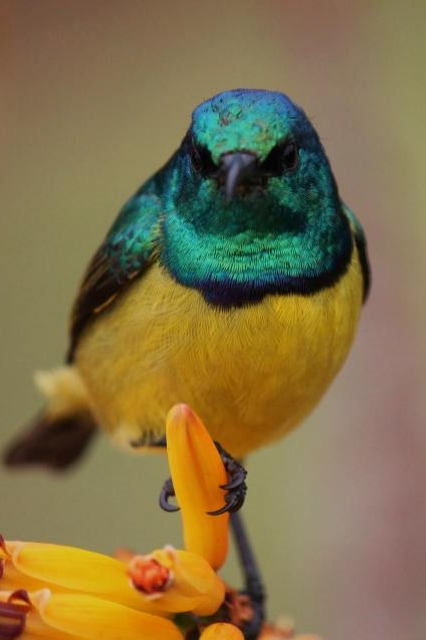 © General Gump
© General Gump
Male, Kruger National Park, Skukuza
 © Dewi
© Dewi
Male, KwaZuu-Natal
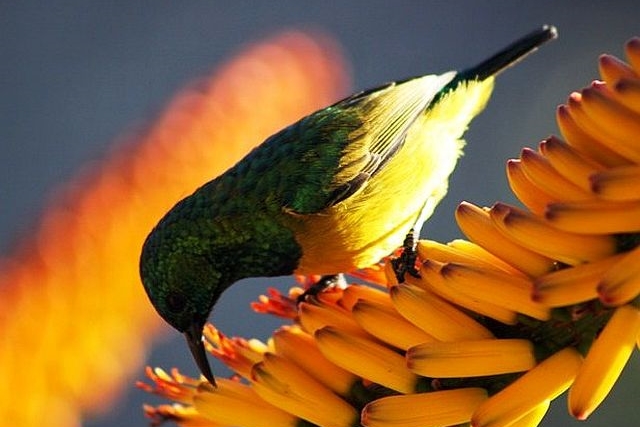 © Heksie
© Heksie
Male
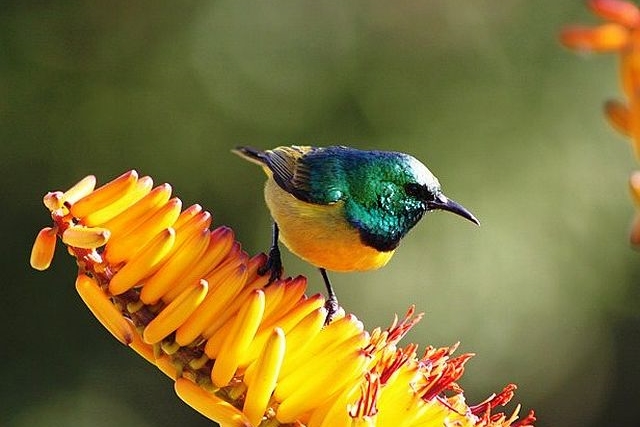 © Heksie
© Heksie
Male
 © BluTuna
© BluTuna
Female, Kruger National Park
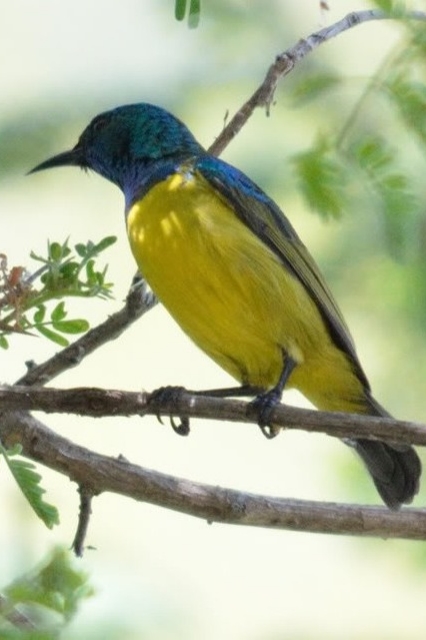 © BluTuna
© BluTuna
Male
 © Dewi
© Dewi
Female, KwaZuu-Natal
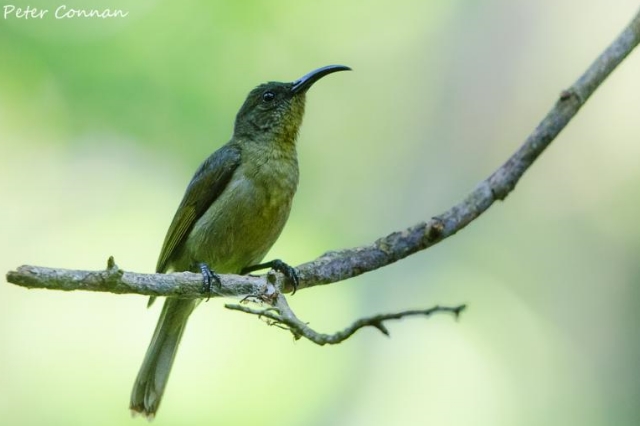 © Peter Connan
© Peter Connan
Female, Maphelane, iSimangaliso Wetland Park, KwaZulu-Natal
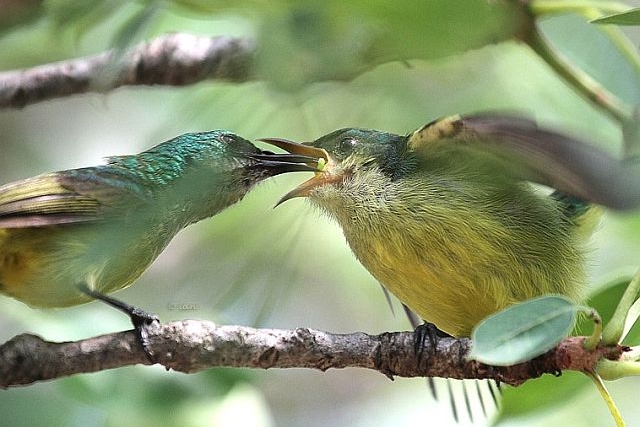 © leachy
© leachy
Links:
Species Text Sabap1
Sabap2
Ian Sinclair. SASOL VOELS VAN SUIDER AFRICA (3de UIT)
 © General Gump
© General GumpMale, Kruger National Park, Skukuza
 © Dewi
© DewiMale, KwaZuu-Natal
 © Heksie
© HeksieMale
 © Heksie
© HeksieMale
 © BluTuna
© BluTunaFemale, Kruger National Park
 © BluTuna
© BluTunaMale
 © Dewi
© DewiFemale, KwaZuu-Natal
 © Peter Connan
© Peter ConnanFemale, Maphelane, iSimangaliso Wetland Park, KwaZulu-Natal
 © leachy
© leachyLinks:
Species Text Sabap1
Sabap2
Ian Sinclair. SASOL VOELS VAN SUIDER AFRICA (3de UIT)
-
Michele Nel
- Posts: 1994
- Joined: Mon Sep 10, 2012 10:19 am
- Country: South Africa
- Location: Cape Town
- Contact:
Orange-breasted Sunbird
777. Orange-breasted Sunbird Anthobaphes violacea (Oranjeborssuikerbekkie)
Order: Passeriformes. Family: Nectariniidae
Description
A slender sunbird, the male with a bright orange breast. Size 12 cm (female) 15 cm (male). As with other sunbirds the bill is long and decurved, that of the male being longer than that of the female. The bill, legs and feet are black. The eye is dark brown.
Adult male: Head, neck, upper mantle and upper scapulars metallic bottle green. Remainder of upper parts olive green. Tail brown, rectrices edged olive green; long and graduated, central rectrices projecting ca 20 mm. Lesser upper wing coverts metallic bottle green, remainder of coverts dark brown, edged olive green. Flight feathers dark brown, edged yellowish olive. Pectoral tufts yellow. Upper breast with narrow violet band; mid- to lower breast orange, paling to yellow belly and orange-tinged undertail coverts. Bill black. Eyes dark brown. Legs and feet black.
Adult female: Crown, ear coverts and sides of neck olive green, tinged brownish. Remainder of upper parts olive greenish grey. Tail dark brown, rectrices edged yellowish olive. Upper wing coverts dark brown, edged olive green. Flight feathers dark brown, edged yellowish olive. Underparts olivaceous yellow, belly sometimes tinged orange. Wings and tail blackish.
The juvenile resembles the female.
Similar species: Female differs from female Southern Double-collared Sunbird in yellower underparts. Female Southern Double-collared and Greater Double-collared Sunbirds have breast and belly less yellow, more olive. Female Malachite Sunbird much larger and longer billed. Female Amethyst Sunbird greyer above, with streaked (not plain) breast.
Distribution
Western and Eastern Cape, South Africa. From Vanrhynsdorp to Port Elizabeth.
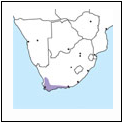
Habitat
Endemic to the fynbos biome, generally preferring dense stands of Protea and Erica. It also occurs in coastal renosterveld and occasionally gardens, provided that there are enough nectar producing plants such as Aloe.
Diet
It eats nectar supplemented with small arthropods, gleaning them from leaves and branches, plucking from the ground and occasionally hawking insects aerially.
Breeding
The nest is built by solely by the female in about 15-18 days, consisting of a sturdy oval with a circular side entrance, built of dry twiglets, heather and soft plant material bound together with spider web. The interior is thickly lined with fluff taken from Protea, alien Blackwood (Acacia melanoxylon) and Kapokbos (Eriocephalus africanus). It is typically placed facing south or south-east, to avoid prevailing wind and rain, in a bush, shrub or tree, especially Protea and Erica. Egg-laying season is almost year-round, peaking from June-September in the Cape Peninsula, Western Cape, earlier in other areas around April-July. It lays 1-2 eggs, which are incubated solely by the female for about 13-16 days. The chicks are brooded in the night until just after they fledge and are fed by both parents, on a diet of mainly arthropods. They usually leave the nest at about 14-22 days old, coming back to the nest to roost for 5-15 days longer, soon afterwards becoming fully independent.
Call
The call is a twangy, weak ssharaynk or sskrang, often repeated. Listen to Bird Call.
Status
Common endemic.
Order: Passeriformes. Family: Nectariniidae
Description
A slender sunbird, the male with a bright orange breast. Size 12 cm (female) 15 cm (male). As with other sunbirds the bill is long and decurved, that of the male being longer than that of the female. The bill, legs and feet are black. The eye is dark brown.
Adult male: Head, neck, upper mantle and upper scapulars metallic bottle green. Remainder of upper parts olive green. Tail brown, rectrices edged olive green; long and graduated, central rectrices projecting ca 20 mm. Lesser upper wing coverts metallic bottle green, remainder of coverts dark brown, edged olive green. Flight feathers dark brown, edged yellowish olive. Pectoral tufts yellow. Upper breast with narrow violet band; mid- to lower breast orange, paling to yellow belly and orange-tinged undertail coverts. Bill black. Eyes dark brown. Legs and feet black.
Adult female: Crown, ear coverts and sides of neck olive green, tinged brownish. Remainder of upper parts olive greenish grey. Tail dark brown, rectrices edged yellowish olive. Upper wing coverts dark brown, edged olive green. Flight feathers dark brown, edged yellowish olive. Underparts olivaceous yellow, belly sometimes tinged orange. Wings and tail blackish.
The juvenile resembles the female.
Similar species: Female differs from female Southern Double-collared Sunbird in yellower underparts. Female Southern Double-collared and Greater Double-collared Sunbirds have breast and belly less yellow, more olive. Female Malachite Sunbird much larger and longer billed. Female Amethyst Sunbird greyer above, with streaked (not plain) breast.
Distribution
Western and Eastern Cape, South Africa. From Vanrhynsdorp to Port Elizabeth.

Habitat
Endemic to the fynbos biome, generally preferring dense stands of Protea and Erica. It also occurs in coastal renosterveld and occasionally gardens, provided that there are enough nectar producing plants such as Aloe.
Diet
It eats nectar supplemented with small arthropods, gleaning them from leaves and branches, plucking from the ground and occasionally hawking insects aerially.
Breeding
The nest is built by solely by the female in about 15-18 days, consisting of a sturdy oval with a circular side entrance, built of dry twiglets, heather and soft plant material bound together with spider web. The interior is thickly lined with fluff taken from Protea, alien Blackwood (Acacia melanoxylon) and Kapokbos (Eriocephalus africanus). It is typically placed facing south or south-east, to avoid prevailing wind and rain, in a bush, shrub or tree, especially Protea and Erica. Egg-laying season is almost year-round, peaking from June-September in the Cape Peninsula, Western Cape, earlier in other areas around April-July. It lays 1-2 eggs, which are incubated solely by the female for about 13-16 days. The chicks are brooded in the night until just after they fledge and are fed by both parents, on a diet of mainly arthropods. They usually leave the nest at about 14-22 days old, coming back to the nest to roost for 5-15 days longer, soon afterwards becoming fully independent.
Call
The call is a twangy, weak ssharaynk or sskrang, often repeated. Listen to Bird Call.
Status
Common endemic.
-
Michele Nel
- Posts: 1994
- Joined: Mon Sep 10, 2012 10:19 am
- Country: South Africa
- Location: Cape Town
- Contact:
Orange-breasted Sunbird Photos
777. Orange-breasted Sunbird Anthobaphes violacea
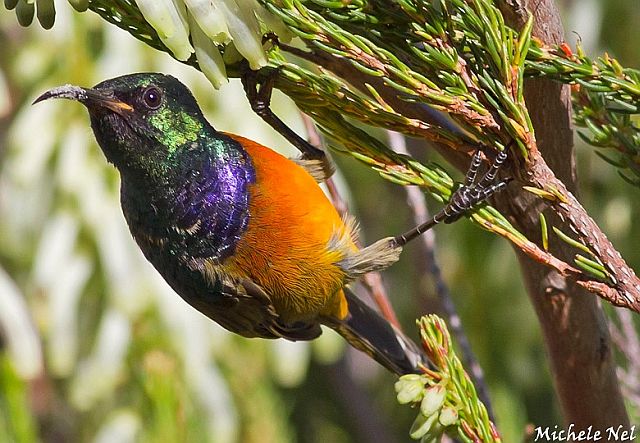

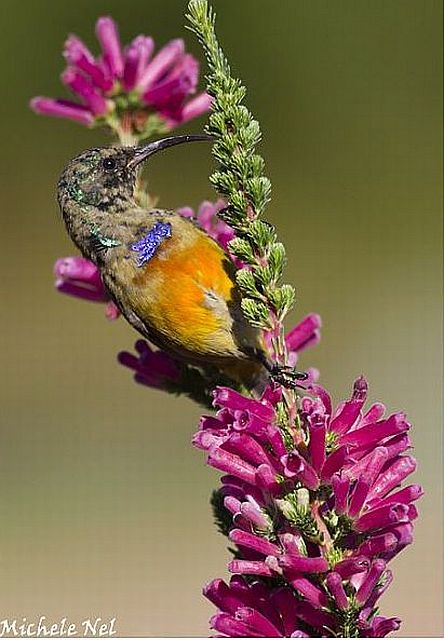
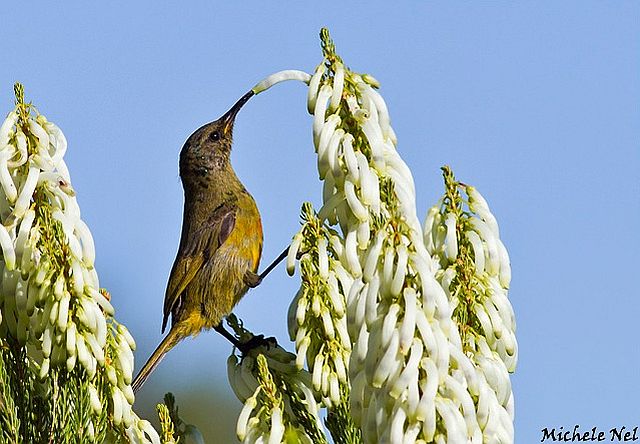
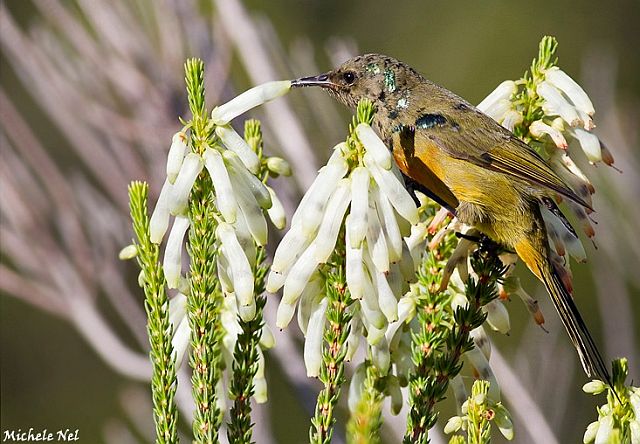
Feeding on Erica gilva

 © Flutterby
© Flutterby
Links:
Species text Sabap1
Sabap2
Wikipedia: http://en.wikipedia.org/wiki/Orange-breasted_Sunbird
Biodiversity Explorer





Feeding on Erica gilva

 © Flutterby
© FlutterbyLinks:
Species text Sabap1
Sabap2
Wikipedia: http://en.wikipedia.org/wiki/Orange-breasted_Sunbird
Biodiversity Explorer
- Flutterby
- Posts: 44029
- Joined: Sat May 19, 2012 12:28 pm
- Country: South Africa
- Location: Gauteng, South Africa
- Contact:
Olive Sunbird
790. Olive Sunbird Cyanomitra olivacea (Olyfsuikerbekkie)
Order: Passeriformes. Family: Nectariniidae
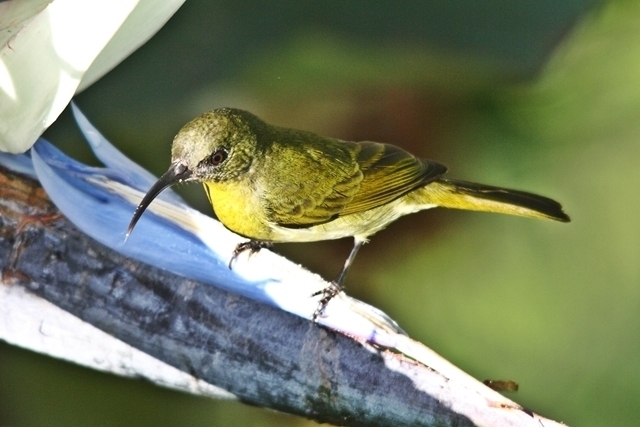 © Flutterby
© Flutterby
Ballito, KwaZulu-Natal
Description
Length: 13-16 cm; sexes alike. Above olive green, faintly metallic in good light.
Adult: Crown, neck, mantle and back olivaceous. Lores, cheeks and ear coverts brownish black, tinged olive. Tail dark greyish brown, rectrices fringed olive green. Chin and throat olivaceous. Breast and belly yellowish green, lower belly and flanks darker olive. Bill black. Eyes dark brown. Legs and feet black.
Juvenile: Washed gold and rufous on throat.
Similar species: Similar to male Malachite Sunbird, but more olive green, less contrast between upper and underparts; habitat different. The similar Grey Sunbird is more greenish grey above and grey below and has scarlet pectoral tufts.
Taxonomy
This is one of the seven Sunbirds that have recently been moved into the genus Cyanomitra from the genus Nectarinia.
In 1993 it was suggested that this species be split (into Eastern Olive Sunbird and Western Olive Sunbird) based on the presence or absence of yellow pectoral tufts in females. However, a genetic study (Bowie et al., 2004) has shown that most of the genetic variation in this species is concentrated in East Africa, with birds from South Africa being similar to those from as far away as Congo, Cameroon and Ghana.
Distribution
Occurs in West Africa and across the DRC, extending south through Tanzania, Zambia and Malawi to southern Africa. Here it is common in central and southern Mozambique and Swaziland, in South Africa confined to extreme East from around East London northwards; vagrant to Grahamstown.
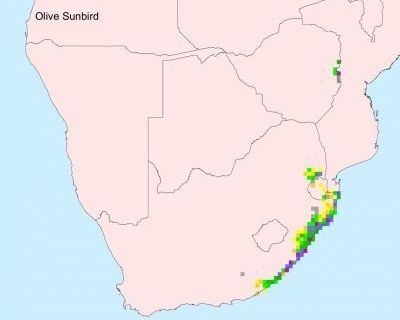
Habitat
It generally prefers coastal or riverine evergreen forests and thickets, but it also occupies dense woodland, banana and Eucalyptus plantations and well-wooded gardens.
Diet
It mainly feeds on nectar (especially of Strelitzia nicolai, Burchellia, Erythrina, Scadoxus, Halleria, Leonotis and mistletoes), insects (including butterflies) and spiders, gleaning prey from foliage and spider webs and hawking insects aerially.
Breeding
The nest is built solely by the female, consisting of an elongate, pear-shaped structure made of a variety of materials, such as fine grass, twiglets, moss, lichen, leaves and Marasmius fungus bound together with spider web. The entrance hole is placed on the side, covered by a small roof, while the interior is typically lined with feathers, seed down and other fine fibres. It is typically attached at the roof to a branch or creeper beneath a dense canopy, or alternatively it can be put amongst roots and cavernous hollows on the ground in the forest or beside a stream, or even within a building or in a hanging basket. Egg-laying season is from August-March, peaking from September-January. It lays 1-3 eggs, which are incubated solely by the female for about 13-16 days. The chicks are fed by both parents, leaving the nest after about 13-16 days.
Call
Loud piping phrases of comparatively deliberate notes, starting slowly then speeding up slightly, falling in pitch towards end, tip tip tip ti-tu-tu-tu-tiup tippy tuti.
Status
Common resident.
Order: Passeriformes. Family: Nectariniidae
 © Flutterby
© FlutterbyBallito, KwaZulu-Natal
Description
Length: 13-16 cm; sexes alike. Above olive green, faintly metallic in good light.
Adult: Crown, neck, mantle and back olivaceous. Lores, cheeks and ear coverts brownish black, tinged olive. Tail dark greyish brown, rectrices fringed olive green. Chin and throat olivaceous. Breast and belly yellowish green, lower belly and flanks darker olive. Bill black. Eyes dark brown. Legs and feet black.
Juvenile: Washed gold and rufous on throat.
Similar species: Similar to male Malachite Sunbird, but more olive green, less contrast between upper and underparts; habitat different. The similar Grey Sunbird is more greenish grey above and grey below and has scarlet pectoral tufts.
Taxonomy
This is one of the seven Sunbirds that have recently been moved into the genus Cyanomitra from the genus Nectarinia.
In 1993 it was suggested that this species be split (into Eastern Olive Sunbird and Western Olive Sunbird) based on the presence or absence of yellow pectoral tufts in females. However, a genetic study (Bowie et al., 2004) has shown that most of the genetic variation in this species is concentrated in East Africa, with birds from South Africa being similar to those from as far away as Congo, Cameroon and Ghana.
Distribution
Occurs in West Africa and across the DRC, extending south through Tanzania, Zambia and Malawi to southern Africa. Here it is common in central and southern Mozambique and Swaziland, in South Africa confined to extreme East from around East London northwards; vagrant to Grahamstown.

Habitat
It generally prefers coastal or riverine evergreen forests and thickets, but it also occupies dense woodland, banana and Eucalyptus plantations and well-wooded gardens.
Diet
It mainly feeds on nectar (especially of Strelitzia nicolai, Burchellia, Erythrina, Scadoxus, Halleria, Leonotis and mistletoes), insects (including butterflies) and spiders, gleaning prey from foliage and spider webs and hawking insects aerially.
Breeding
The nest is built solely by the female, consisting of an elongate, pear-shaped structure made of a variety of materials, such as fine grass, twiglets, moss, lichen, leaves and Marasmius fungus bound together with spider web. The entrance hole is placed on the side, covered by a small roof, while the interior is typically lined with feathers, seed down and other fine fibres. It is typically attached at the roof to a branch or creeper beneath a dense canopy, or alternatively it can be put amongst roots and cavernous hollows on the ground in the forest or beside a stream, or even within a building or in a hanging basket. Egg-laying season is from August-March, peaking from September-January. It lays 1-3 eggs, which are incubated solely by the female for about 13-16 days. The chicks are fed by both parents, leaving the nest after about 13-16 days.
Call
Loud piping phrases of comparatively deliberate notes, starting slowly then speeding up slightly, falling in pitch towards end, tip tip tip ti-tu-tu-tu-tiup tippy tuti.
Status
Common resident.
- Flutterby
- Posts: 44029
- Joined: Sat May 19, 2012 12:28 pm
- Country: South Africa
- Location: Gauteng, South Africa
- Contact:
Olive Sunbird Photos
790. Olive Sunbird Cyanomitra olivacea
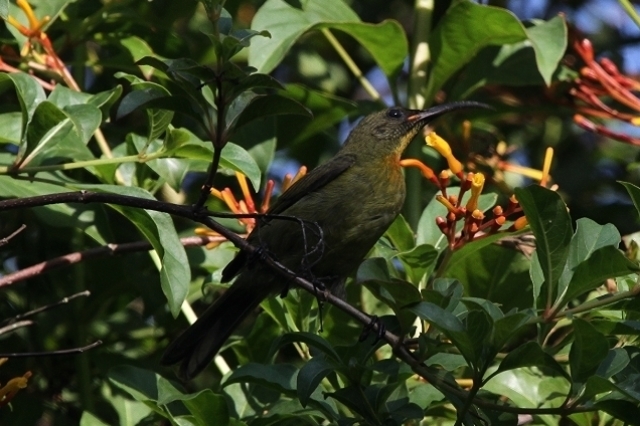 © Tina
© Tina
Links:
Sabap2: http://sabap2.adu.org.za/species_info.p ... #menu_left
Sabap 1 Species text: http://sabap2.adu.org.za/docs/sabap1/790.pdf
Newman's Birds of Southern Africa
SASOL VOELS VAN SUIDER AFRICA (3de UIT)
Percy FitzPatrick Institute of African Ornithology: http://www.fitzpatrick.uct.ac.za/africa ... tzfm06.pdf
 © Tina
© TinaLinks:
Sabap2: http://sabap2.adu.org.za/species_info.p ... #menu_left
Sabap 1 Species text: http://sabap2.adu.org.za/docs/sabap1/790.pdf
Newman's Birds of Southern Africa
SASOL VOELS VAN SUIDER AFRICA (3de UIT)
Percy FitzPatrick Institute of African Ornithology: http://www.fitzpatrick.uct.ac.za/africa ... tzfm06.pdf
Grey Sunbird
789. Grey Sunbird Cyanomitra veroxii (Gryssuikerbekkie)
Order: Passeriformes. Family: Nectariniidae
Description
Length 14-15 cm. Sexes alike; A dull-coloured sunbird with uniformly pale grey underparts, above greyish, feathers edged metallic green (not usually visible in field); below paler grey, tinged olive, washed yellowish on flanks; wings and tail black. May show red pectoral tufts. Iris dark brown; bill, legs and feet black.
Juvenile: More olive below than adult.
Similar species: Similar to Olive Sunbird in structure, but plumage is mostly cold grey with a darker tail.
Distribution
Occurs along the eastern coastline of sub-Saharan Africa, from Somalia through Kenya and Tanzania to southern Africa. Here it is locally common down the coast from eastern Mozambique to KwaZulu-Natal and the Eastern Cape.
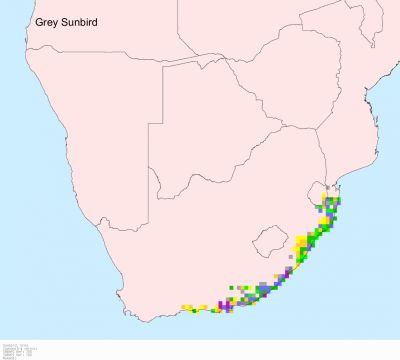
Habitat
Coastal evergreen forest, well-developed valley bushveld and patches of Afromontane forest further inland.
Movements and migrations
Nomadic and partially migratory, as it is thought that it migrates from the Eastern Cape to KwaZulu-Natal in winter.
Diet
It mainly eats nectar, foraging throughout the day and also eating termites and other small arthropods.
Breeding
The nest is a peculiar oval-shaped structure with a side entrance covered by a large flap, often with a long tail of material protruding from its base. It is usually built of fine, hair-like fibres such as Marasmius fungus, camouflaged with a thick layer of dead leaves and leaf petioles and lined with dry grass. It is typically suspended at the roof by a long strand of material to a twig or creeper overlooking a small forest clearing, path or road, or occasionally from roots on the side of an erosion gullly and even in little-used buildings. It lays 1-4, usually 2-3 chocolate brown eggs, usually in the period from September-January.
Call
Song loud monotonously repeated sparrowlike CHIP CHIP-CHIP or CHIP CHIP, or longer phrase like chip chip chip jip-jip-jip-jip-jeep, sharting off quietly and deliberately, ending loudly and fast; or penetrating rapid piping ti-ti-ti-ti-ti-ti-tu-jip; quiet sustained subsong of twittering notes; various sharp zit, tsip and tseep-chip-cha callnotes; sharp skiree-riree-riree alarm calls.
Status
Fairly common resident; subject to some local movements.
Order: Passeriformes. Family: Nectariniidae
Description
Length 14-15 cm. Sexes alike; A dull-coloured sunbird with uniformly pale grey underparts, above greyish, feathers edged metallic green (not usually visible in field); below paler grey, tinged olive, washed yellowish on flanks; wings and tail black. May show red pectoral tufts. Iris dark brown; bill, legs and feet black.
Juvenile: More olive below than adult.
Similar species: Similar to Olive Sunbird in structure, but plumage is mostly cold grey with a darker tail.
Distribution
Occurs along the eastern coastline of sub-Saharan Africa, from Somalia through Kenya and Tanzania to southern Africa. Here it is locally common down the coast from eastern Mozambique to KwaZulu-Natal and the Eastern Cape.

Habitat
Coastal evergreen forest, well-developed valley bushveld and patches of Afromontane forest further inland.
Movements and migrations
Nomadic and partially migratory, as it is thought that it migrates from the Eastern Cape to KwaZulu-Natal in winter.
Diet
It mainly eats nectar, foraging throughout the day and also eating termites and other small arthropods.
Breeding
The nest is a peculiar oval-shaped structure with a side entrance covered by a large flap, often with a long tail of material protruding from its base. It is usually built of fine, hair-like fibres such as Marasmius fungus, camouflaged with a thick layer of dead leaves and leaf petioles and lined with dry grass. It is typically suspended at the roof by a long strand of material to a twig or creeper overlooking a small forest clearing, path or road, or occasionally from roots on the side of an erosion gullly and even in little-used buildings. It lays 1-4, usually 2-3 chocolate brown eggs, usually in the period from September-January.
Call
Song loud monotonously repeated sparrowlike CHIP CHIP-CHIP or CHIP CHIP, or longer phrase like chip chip chip jip-jip-jip-jip-jeep, sharting off quietly and deliberately, ending loudly and fast; or penetrating rapid piping ti-ti-ti-ti-ti-ti-tu-jip; quiet sustained subsong of twittering notes; various sharp zit, tsip and tseep-chip-cha callnotes; sharp skiree-riree-riree alarm calls.
Status
Fairly common resident; subject to some local movements.
Grey Sunbird Photos
789. Grey Sunbird Cyanomitra veroxii
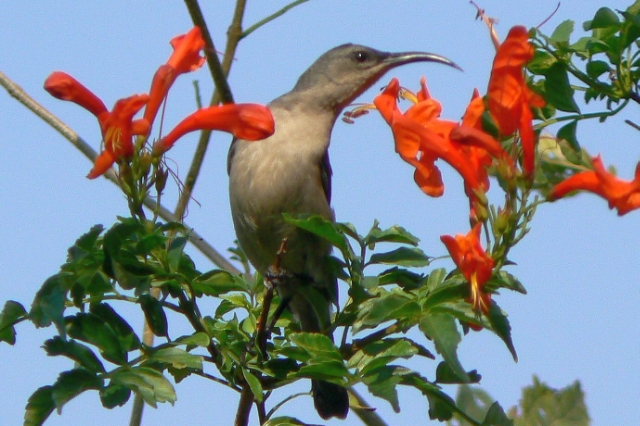
Hluhluwe, Hilltop
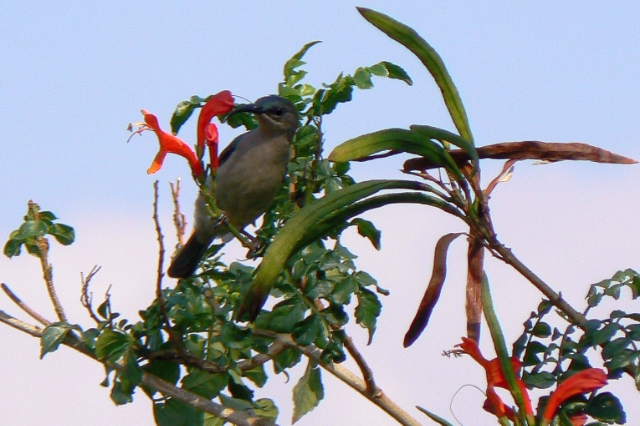
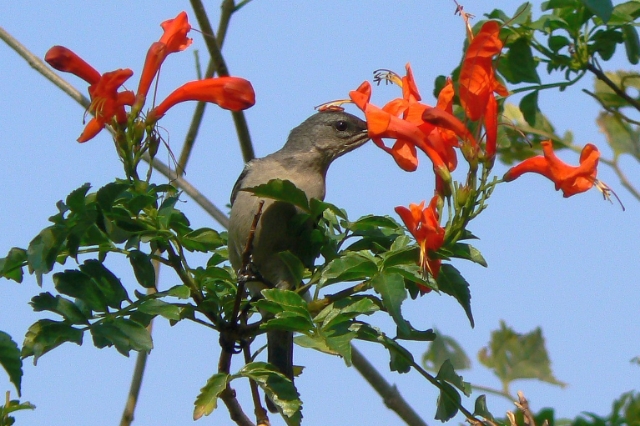
Hilltop camp, Hluhluwe
Links:
Sabap2
SASOL VOELS VAN SUIDER AFRICA (3de UIT)

Hluhluwe, Hilltop


Hilltop camp, Hluhluwe
Links:
Sabap2
SASOL VOELS VAN SUIDER AFRICA (3de UIT)


